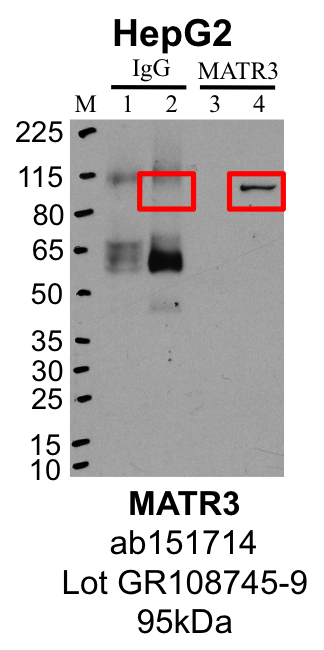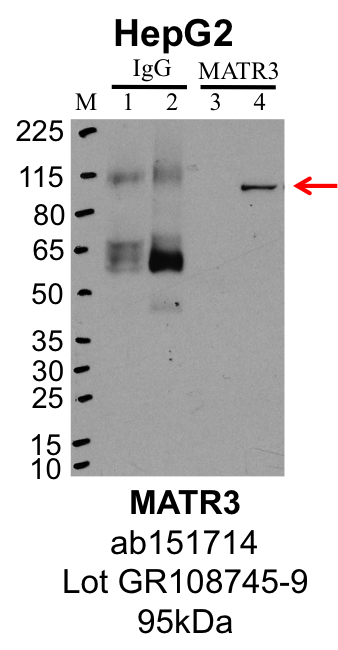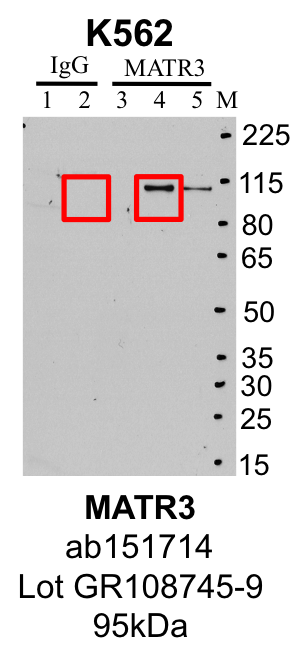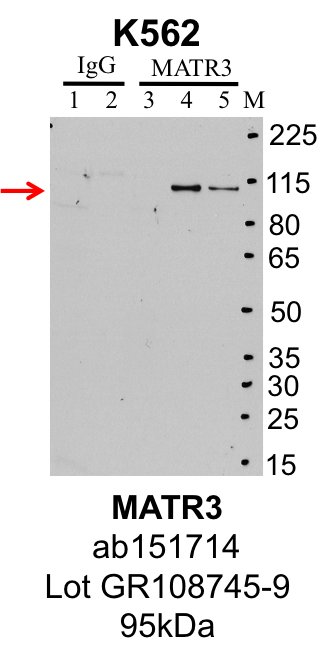ENCAB789SRM
Antibody against Homo sapiens MATR3
Homo sapiens
K562, HepG2
characterized to standards
- Status
- released
- Source (vendor)
- Abcam
- Product ID
- ab151714
- Lot ID
- GR108745-9
- Characterized targets
- MATR3 (Homo sapiens)
- Host
- rabbit
- Clonality
- monoclonal
- Purification
- tissue culture supernatant
- Isotype
- IgG
- Antigen description
- Synthetic peptide (the amino acid sequence is considered to be commercially sensitive) within Human Matrin 3 aa 750 to the C-terminus.
- Antigen sequence
- The exact sequence is proprietary.
- External resources
Characterizations
MATR3 (Homo sapiens)
HepG2
compliant
- Caption
- Representative image of immunoprecipitation performed on whole cell extracts from the HepG2 cell line using the MATR3 specific antibody ab151714. Lane 1: Input from IP using control IgG. Lane 2: Immunoprecipitated material using control IgG. Lane 3: Input from IP using MATR3 antibody. Lane 4: Immunoprecipitated material using MATR3 antibody. Outlined regions were excised from gel and subjected to analysis by mass spectrometry. Target molecular weight: 94.62kDa.
- Reviewer comment
- Duplicate blot image as previously submitted IP
- Submitted by
- Steven Blue
- Lab
- Gene Yeo, UCSD
- Grant
- U54HG007005
MATR3 (Homo sapiens)
HepG2
compliant
- Caption
- IP-Western Blot analysis of HepG2 whole cell lysate using MATR3 specific antibody. Lane 1 is 1% of twenty million whole cell lysate input and lane 2 is 10% of IP enrichment using rabbit normal IgG (lanes under 'IgG'). Lane 3 is 1% of twenty million whole cell lysate input and lanes 4 is 10% IP enrichment using rabbit polyclonal MATR3 antibody (lanes under 'MATR3').
- Submitted by
- Steven Blue
- Lab
- Gene Yeo, UCSD
- Grant
- U54HG007005
MATR3 (Homo sapiens)
K562
compliant
- Caption
- Representative image of immunoprecipitation performed on whole cell extracts from the K562 cell line using the MATR3-specific antibody ab151714. Lane 1: Input from IP using control IgG. Lane 2: Immunoprecipitated material using control IgG. Lane 3: Input from IP using MATR3 antibody. Lane 4: Immunoprecipitated material using MATR3 antibody. Outlined regions were excised from gel and subjected to analysis by mass spectrometry. Target molecular weight: 94.62 kDa.
- Reviewer comment
- Duplicate blot image as previously submitted IP
- Submitted by
- Steven Blue
- Lab
- Gene Yeo, UCSD
- Grant
- U54HG007005
MATR3 (Homo sapiens)
K562
compliant
- Caption
- IP-Western Blot analysis of K562 whole cell lysate using MATR3 specific antibody. Lane 1 is 1% of twenty million whole cell lysate input and lane 2 is 10% of IP enrichment using rabbit normal IgG (lanes under 'IgG'). Lane 3 is 1% of twenty million whole cell lysate input and lanes 4 and 5 are 10% IP enrichment of biological replicates using rabbit polyclonal MATR3 antibody (lanes under 'MATR3').
- Submitted by
- Steven Blue
- Lab
- Gene Yeo, UCSD
- Grant
- U54HG007005
MATR3 (Homo sapiens)
Method: immunoprecipitation followed by mass spectrometry
compliant
- Caption
- IP followed by mass spectrometry. Protein was immunoprecipitated from HepG2 whole cell lysates using the antibody ab151714, loaded on a 4-12% NuPAGE Bis-Tris gel, and separated via electrophoresis. Using a reference western blot done in parallel, gel pieces corresponding to the sections indicated were excised and submitted for analysis by the UCSD Biomolecular and Proteomics Mass Spectrometry Facility.
- Submitted by
- Steven Blue
- Lab
- Gene Yeo, UCSD
- Grant
- U54HG007005
- Download
- MATR3 HepG2.pdf
MATR3 (Homo sapiens)
Method: immunoprecipitation followed by mass spectrometry
not reviewed
- Caption
- IP followed by mass spectrometry. Protein was immunoprecipitated from K562 whole cell lysates using the antibody ab151714, loaded on a 4-12% NuPAGE Bis-Tris gel, and separated via electrophoresis. Using a reference western blot done in parallel, gel pieces corresponding to the sections indicated were excised and submitted for analysis by the UCSD Biomolecular and Proteomics Mass Spectrometry Facility.
- Reviewer comment
- Not sure how to review, the target factor is top ranked by fold enrichment over IgG but a different factor (ZC3H11A) is second ranked by peptide count but no peptides were detected in the IgG control. However, given there is a passing IP-MS in HepG2, review of this secondary is not required.
- Submitted by
- Steven Blue
- Lab
- Gene Yeo, UCSD
- Grant
- U54HG007005
- Download
- MATR3 K562.pdf



